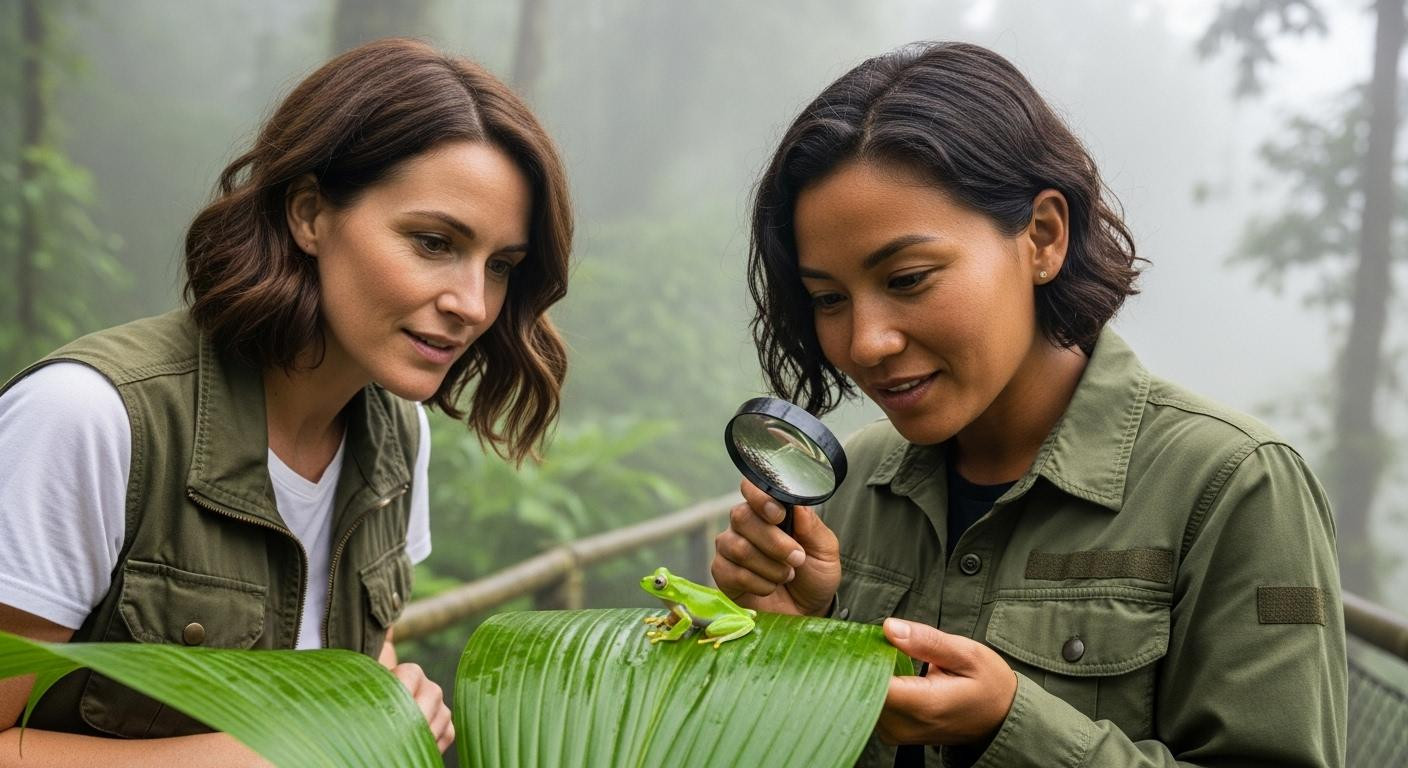Dawn breaks at 6:47 AM as you join a biologist through Mashpi Lodge’s cloud forest. Mist curls around century-old trees while a glass frog clings to translucent leaves. Three days ago, luxury meant thread counts and infinity pools. Now, watching this scientist document biodiversity with genuine reverence, something fundamental shifts. This isn’t vacation. It’s transformation through conservation. Sustainable hotels reveal what traditional resorts conceal: that true luxury lies not in isolation from nature but integration with it, not in consuming resources but protecting them.
When conservation becomes the journey itself
The scene at these properties differs fundamentally from resort arrivals. Mashpi Lodge’s orientation introduces guests to ongoing research projects instead of poolside cocktail schedules. Arctic Bath’s check-in includes traditional Sámi cultural protocols rather than spa upselling. The Datai Langkawi’s welcome briefing covers coral restoration efforts while most hotels discuss room service timing.
Staff aren’t hospitality professionals trained to serve. They’re conservation partners inviting participation. Guests don’t spectate nature through lobby windows. They contribute to its documentation and protection through guided research walks, traditional wellness practices, and hands-on environmental stewardship that transforms perspective on travel’s deeper purpose.
How architecture embodies environmental philosophy
The revelation lies in purpose-driven design that serves environmental mission while delivering luxury. Every architectural choice at these properties advances conservation goals rather than merely impressing guests.
Design that minimizes footprint while maximizing impact
Song Saa’s reclaimed materials create zero-waste elegance from salvaged wood and recycled elements. Arctic Bath’s floating structure adapts to seasonal river changes without permanent environmental disruption. COMO Laucala Island’s 90% self-sustainability transforms farming into guest experience rather than hiding agricultural operations. Each design element serves environmental purpose: solar orientation reduces energy consumption, rainwater harvesting eliminates municipal dependence, natural ventilation systems eliminate mechanical cooling needs.
Cultural integration through built environment
Mashpi Lodge employs local staff trained in both hospitality and conservation science, creating employment that preserves traditional knowledge. Arctic Bath incorporates Sámi wellness traditions into its spa programming rather than importing generic luxury treatments. The Datai Langkawi’s architecture frames ancient rainforest rather than dominating it, allowing 10-million-year-old ecosystem to remain the primary visual focus.
The daily rhythm of purposeful luxury
Morning routines at sustainable hotels differ dramatically from traditional resort experiences. Activities connect guests directly to conservation missions and local cultures.
Morning activities that build connection
Mashpi Lodge: 6:30 AM biologist-guided nature walks document species for ongoing research projects rather than staged wildlife viewing. Arctic Bath: Dawn sauna rituals follow traditional Sámi wellness practices passed down through generations. Song Saa: Sunrise coral restoration dives with marine biologists contribute to reef preservation rather than casual snorkeling tours. The Datai Langkawi: Ranger-led rainforest treks identify medicinal plants using indigenous knowledge systems.
Cuisine that celebrates self-sustainability
Every meal tells the property’s conservation story through locally sourced ingredients. COMO Laucala Island grows 80% of ingredients on-island through organic farming that guests can explore and participate in. Mashpi Lodge sources nearly 80% of ingredients from local farming cooperatives, supporting regional biodiversity preservation. Song Saa’s menu features sustainable-catch seafood from community fishing partnerships that promote responsible harvesting methods.
Why transformation outlasts traditional luxury
Traditional resorts offer temporary escape. You return unchanged to familiar consumption patterns. These sustainable sanctuaries offer perspective shifts that endure beyond checkout dates. Guests leave understanding their environmental footprint, appreciating cultural preservation efforts, recognizing that luxury and conservation aren’t opposing forces but complementary values creating more meaningful travel experiences.
The $1,450 Mashpi Lodge rate isn’t expensive accommodation. It’s investment in biodiversity protection that funds ongoing research. Arctic Bath’s $950 nightly rate supports Sámi cultural preservation and zero-waste innovations. Every booking becomes conservation funding, every stay a contribution to environmental stewardship extending far beyond individual vacation experiences.
Your questions about sustainable luxury hotels answered
How do sustainable hotels balance luxury with environmental responsibility?
Through innovation rather than compromise or reduction in comfort levels. Arctic Bath’s zero-waste design doesn’t diminish luxury amenities but enhances authenticity through traditional Sámi practices. Song Saa’s reclaimed materials create unique aesthetic character impossible to replicate with conventional construction. COMO Laucala Island’s self-sustainability provides fresher ingredients than imported luxury goods, making conservation the premium differentiator rather than its limitation.
What makes these properties worth premium pricing versus traditional resorts?
Rates fund conservation missions, employ local communities, and provide transformative experiences impossible at conventional properties focused solely on guest services. Mashpi Lodge’s $1,450 includes biologist access and research participation that contribute to scientific understanding. Guests don’t just observe nature through guided tours but actively participate in its protection through specialized programming unavailable elsewhere in traditional hospitality.
When is the optimal season to experience these sustainable sanctuaries?
Mashpi Lodge: May-November dry season offers optimal wildlife viewing with 75°F average temperatures. Arctic Bath: Winter months December-March provide Northern Lights viewing, summer offers midnight sun experiences. The Datai Langkawi: December-April dry season avoids monsoon disruptions. Song Saa: November-April period avoids heavy monsoons with 82°F water temperatures. COMO Laucala Island: April-October delivers ideal Fiji climate with minimal rainfall.
Your hand trails through 96°F geothermal water at Arctic Bath as aurora borealis ripples overhead. Three days ago, this was bucket-list spectacle. Now it’s personal connection to landscape, culture, conservation mission. The transformation isn’t temporary vacation mindset but permanent perspective shift on travel’s purpose and possibility.
